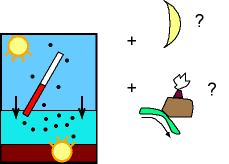Habitable Planets
( \newcommand{\kernel}{\mathrm{null}\,}\)
This page was copied from Nick Strobel's Astronomy Notes. Go to his site at www.astronomynotes.com for the updated and corrected version.
Now that you know what kinds of stars would be good to explore further and what criteria should be used for distinguishing lifeforms from other physical processes, let us hone in on the right kind of planet to support life. Unfortunately, our information about life is limited to one planet, the Earth, so the Earth-bias is there. However, scientists do know of the basics of what life needs and what sort of conditions would probably destroy life. With these cautionary notes, let's move forward.

The habitable planet should have:
- a stable temperature regime provided by an energy source external to the life forms such as the star the planet orbits or planetary heating from some sort of geological activity and
- a liquid mileau. Liquid water is best for biochemical reactions and could be very abundant but liquid methane and/or ethane, like what is found on Saturn's moon Titan might work. Since liquid water dissolves other compounds better than liquid methane/ethane and biochemical sort of reactions work better in liquid water than liquid methane/ethane, liquid water will probably be a requirement for a habitable planet. Water is liquid at a wide temperature range. Bio-chemical reactions will not happen in solids and they would be very inefficient in a gas. Water is liquid at a higher temperature than methane, ethane, and ammonia so chemical reactions will happen more quickly in the liquid water than in the other liquids. Also, frozen water floats! The hydrogen bonds of water make water less dense when it freezes. The frozen water ice could form a protective layer insulating the liquid water below it. The other types of liquids sink when they freeze and could lead to a runaway freezing process where all of the liquid freezes. Finally, water in some form (mostly either gas or solid) is actually quite abundant in the Galaxy so we are not limiting ourselves too much with the water bias. The liquid mileau is needed to mix...
- the essential building block elements together (carbon, hydrogen, nitrogen, oxygen, phosphorus, sulfur, and transition metals like iron, chromium, and nickel). Since the building block elements are only created in the stars, the best places to look for life is around stars formed from processed gas, ie., look at metal-rich stars. Carbon will probably be the base of life because its great versatility to form compounds with other elements and even with itself. Carbon is more likely to share its electrons with other atoms rather than donate its electrons to other atoms or steal electrons from other atoms. Carbon has the highest degree of "catenation" (ability to form chemical bonds to itself) of all the elements. There are far more types of organic compounds (molecules containing carbon and usually also hydrogen) known than all the other types of compounds combined. On a planet with carbon-based life and life using carbon's closest competitor, silicon, as a base, the carbon-based chemical reactions would be far more efficient than the silicon-based ones, so the carbon-based life would quickly overrun any silicon-based life present on the planet. For more on silicon as a base for life, see the Scientific American "Ask the Experts" answer written by Raymond Dessy (link appears in a new window).
- The planet should have a solid surface to concentrate the building block elements together in the liquid on top. The more concentrated the solution of water and molecules is, the more likely the molecules will react with each other. If the molecules were fixed in a solid, they would not be able to get close to each other and react with each other. If the molecules were in a gaseous state, they would be too far apart from each other to react efficiently. Though the reactions could conceivably take place, they would be rare!
- The planet should also have enough gravity to keep an atmosphere. An atmosphere would shield lifeforms on the surface from harmful radiation (charged particles and high-energy photons) and moderate the changes in temperatures between night and day to maintain a stable temperature regime. The atmosphere would also provide the surface pressure needed for the liquid (most likely liquid water) to exist on the surface.
- A relatively large moon nearby may be needed to keep the planet's rotation axis from tilting too much and too quickly. This prevents large differences in temperatures over short timescales (life needs sufficient time to adapt to temperature changes).
- Plate tectonics may be needed to: 1) regulate the surface temperature of the planet via its crucial role in the carbon cycle; 2) create a magnetic field to shield the planet from the deadly stellar winds; 3) create dry land on a water-covered world; and 4) promote a high level of biodiversity across the planet by creating new environments that organisms would have to adapt to.

On planets or moons without an atmosphere and/or that are far from their parent star, it may be possible to have life existing below the surface if the planet or moon have a planetary heating source. An example of this would be Jupiter's moon Europa. It has a water ice crust and a liquid water ocean below and is kept warm despite its great distance from the Sun because of tidal heating from Jupiter's large gravity. Explore the Planetary Habitability Laboratory website for more about the research into what makes a habitable planet and the list of exoplanet websites in the Solar System Fluff chapter for what we're doing to find habitable exoplanets.
Contributors and Attributions
- Nick Strobel (Bakersfield College)
Is this page a copy of Strobel's Astronomy Notes?
Please note that the content of this page does not follow the general CC-SA-NC-BY license of the physwiki.

